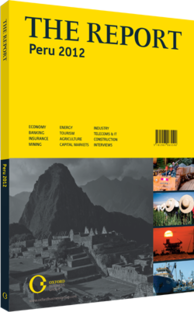A two-pronged approach: Public and private sectors focus on key infrastructure projects
The Supervisory Authority for Investment in Public Transportation Infrastructure (Organismo Supervisor de la Inversión en Infraestructura de Transporte de Uso Público, OSITRAN), Peru’s transportation regulator, estimated in 2010 that the transport infrastructure gap was $13.9bn. This important assessment was followed by the equally significant announcement by the Ministry of Transportation and Communications (MTC) in 2011 that the government had earmarked $20.5bn for infrastructure development between 2011 and 2016.
CRUCIAL INVESTMENT: Peru’s impressive economic performance over the past decade has certainly increased demand for infrastructure development, driven by the success of sectors such as mining, retail and agriculture – all of which demand significant infrastructure networks. However, infrastructure expenditures under the current administration are not solely designed to spur economic growth, but also to address the issue of social inequality, one of President Ollanta Humala’s chief campaign promises.
To do this requires greater investment in Peru’s rural Andean and Amazonian regions. The effect of infrastructure development on reducing poverty gaps and social inequality has been well documented through the years. A 2004 World Bank study on the subject entitled, “The Effects of Infrastructure Development on Growth and Income Distribution”, estimates that Peru’s Gini coefficient (a measure of overall income inequality) would decline if its level of infrastructure were immediately brought in line with that of Chile or Costa Rica.
A RANGE OF BENEFITS: While most infrastructure development is seen as a long-term investment, it does have short-term benefits, and infrastructure projects are often key elements of stimulus packages. The Ministry of Economy and Finance (MEF) reported in November 2011 that it would use small-scale infrastructure projects to spur employment and help offset any economic slowdown brought on by external factors.
In 2010 the first infrastructure development fund was established to assist in driving infrastructure improvement throughout the country. The $460m initiative, labelled the Brookfield Peru Infrastructure Fund, was created by the MEF and received $220m funding from four private pension funds as well as $100m from Brookfield Asset Management (which also acts as fund manager), $100m from state-owned bank Cofide and $40m from the Andean Development Corporation.
PRIVATE SECTOR OPPORTUNITIES: Apart from constructing roads and bridges, concession agreements to operate, maintain and upgrade airports, railways and ports have been tendered regularly over the past decade. To date the state has effectively offered concessions for overseeing the operation of integral transport infrastructure, including: the operation of the southern rail network to Ferrocarril Transandino in 1999, the Jorge Chávez International Airport in 2001 to Lima Airport Partners; two terminals at the Callao Port, first to Dubai Ports World in 2008 and then APM Terminals in 2011.
More concessions are being lined up by the MTC, including the greenfield construction and operation of the $420m Chinchero International Airport and $110m for the General San Martín Port in Pisco. Infrastructure concessions to the private sector through the first half of 2011 amounted to $1.5bn, according OSITRAN.
Rafael Farromeque, the director of consultancy Europraxis-ALG Consulting Andina, emphasises that increased government spending will continue to provide a number of opportunities for the private sector. “Due to the high cost of large-scale infrastructure projects, public-private partnerships are liable to become commonplace in the coming years, providing lots of opportunities to the private sector,” he told OBG.
Indeed, government spending will provide private contractors numerous chances to bid for contracts to develop and maintain infrastructure. Private investment in concession agreements offers a win-win situation – while the government will concede revenues brought in from its various transport infrastructure it will simultaneously be relieved of obligations to invest in and efficiently operate and maintain infrastructure.
You have reached the limit of premium articles you can view for free.
Choose from the options below to purchase print or digital editions of our Reports. You can also purchase a website subscription giving you unlimited access to all of our Reports online for 12 months.
If you have already purchased this Report or have a website subscription, please login to continue.

